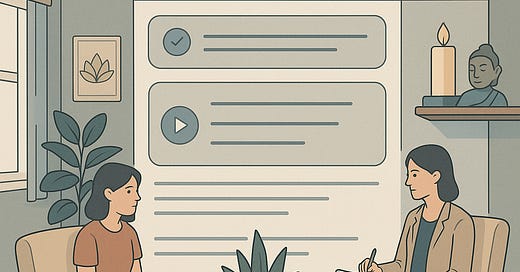Generation Healers: Why Gen Z Might Actually Reverse the Psychosocial Collapse
Their trauma wasn’t a tragedy. It was a software installation.
Millennials discovered therapy.
Gen Z was downloaded into it.
They didn’t rebel into emotional language - they were born into it.
“Attachment style,” “nervous system dysregulation,” “gaslighting,” “inner child,” “somatic healing”—these aren’t therapeutic breakthroughs for them.
They’re base vocabulary.
Pain was not a detour. It was the curriculum.
And healing is no longer a recovery process - it’s a birthright interface.
This generation isn’t broken.
They are the first to treat emotional literacy as a design principle, not a last resort.
And they might be the ones who actually reverse the intergenerational glitch of unresolved psychosocial collapse.
WHEN EMOTIONAL LITERACY BECAME GRAMMAR
Boomers learned to suppress.
Gen X tried to forget.
Millennials learned to name.
Gen Z? They embody it.
Ask a 19-year-old about their relationship patterns and you’ll get a full lecture on:
anxious–avoidant dynamics
pre-verbal trauma
fawn responses
polyvagal theory
boundary violation signalling
These aren’t just academic buzzwords.
They’re tools for survival - delivered through memes, podcasts, TikTok edits, and therapy-core Reels.
Emotional fluency has become cultural capital.
In Gen Z’s world, regulation is the new status symbol.
MASS SHADOW WORK AT SCALE
Once the domain of Jungian retreats or $900 weekend intensives, shadow work is now an algorithmically distributed practice.
Scroll TikTok and you’ll find:
Inner child reparenting affirmations
Guided somatic check-ins
Emotional triggers unpacked by 20-somethings with ring lights
Rapid-fire confessions delivered as narrative blueprints
TikTok has become a shadow-mirroring chamber.
You watch others process what you hadn’t named.
You see your own wounds become cinematic - and then communal.
This is not narcissism.
It’s emotional modeling at scale.
For the first time in human history, hundreds of millions of people are doing asynchronous group therapy - voluntarily, publicly, ritually.
TRAUMA AS INFRASTRUCTURE
Gen Z doesn’t view trauma as a scar.
They view it as:
Code to be debugged
Narratives to be re-authored
Signals to be interpreted
Guidance systems for nervous system recalibration
They don’t pathologise themselves for being broken.
They optimise themselves through breakdown.
This is a radical inversion of every prior generational pattern:
No more bootstraps.
No more “man up.”
No more grit-as-glorification.
Resilience is no longer pain endurance.
It’s coherence - the ability to return to wholeness, faster.
THE RISE OF EMOTIONAL ENTREPRENEURS
Behind the healing are the builders of healing - and they’re not institutions.
They’re Gen Z startups.
You’ve seen them:
20-somethings launching mindfulness journaling apps
micro-communities for trauma bonding
somatic therapy co-working sessions
private Discord servers where strangers heal in real time
Mental health is no longer a clinic.
It’s a service model.
It’s a creator economy.
It’s a community architecture.
They don’t trust legacy systems to do this right.
So they’re building new operating systems for inner peace - and scaling them like software.
A NEW MODEL FOR RESILIENCE
What does Gen Z call strength?
Not brute willpower.
Not perfectionism.
Not cold detachment.
They define strength as:
not spiralling after being ghosted
knowing when your body’s saying “no”
recognising that emotional flooding ≠ identity collapse
pausing, not reacting
Nervous system regulation is the new emotional currency.
Somatic awareness is the new intelligence.
They are teaching us that:
Feeling is not a flaw
Sensitivity is not weakness
Rest is not failure
Stillness is not passivity
They are mapping a post-traumatic clarity economy.
And they’re doing it without waiting for permission.
THE HEALERS ARE HERE
This generation is not lost.
They are not fragile.
They are not avoidant.
They are healers in disguise.
Quietly reprogramming the world, one inner child at a time.
One boundary at a time.
One nervous system reset at a time.
Their trauma wasn’t a glitch.
It was an installation package.
And now, fully online, they’re building futures from the most radical technology ever encoded into a generation:
Self-awareness as system logic.
Compassion as architecture.
Healing as collective software.
“They told me to cope with the world; I chose to reframe it.”
(Perception was never passive.)“My healing didn’t start when I spoke - it started when I stopped believing everything I thought.”
(Silence is where the real update runs.)“The Clarity System didn’t teach me anything new - just reminded me what I forgot before I was taught to forget.”
(You’ve always had root access.)“I stopped chasing purpose the moment I made peace with presence.”
(There is no app for now. There never needed to be.)


